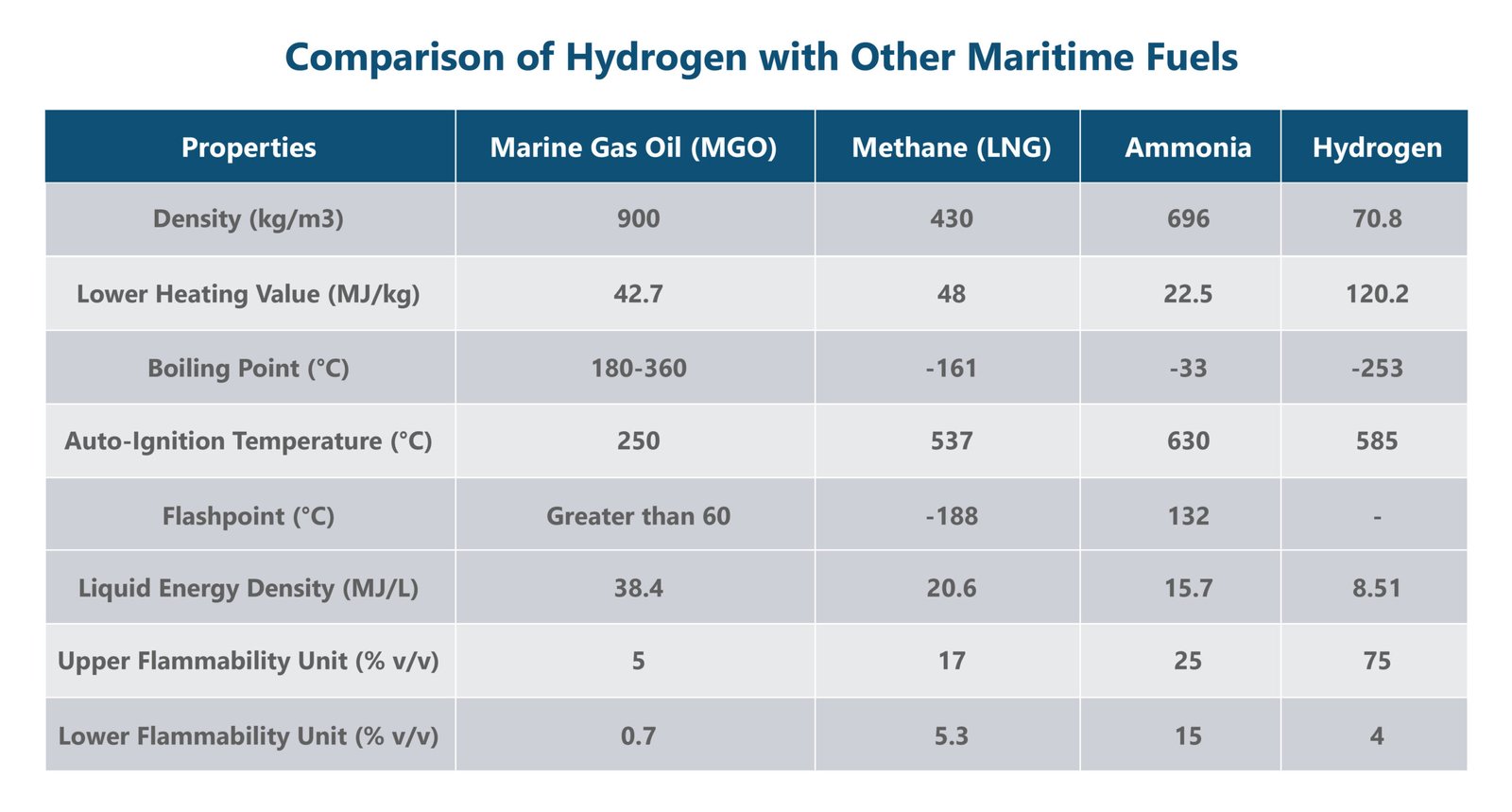-
- The maritime industry faces intense pressure to reduce greenhouse gas (GHG) emissions, curb environmental impact, and sail towards a greener future.
- Certain challenges in shifting to hydrogen include high finances, efficient storage space, and regulatory and policy uncertainties.
- Multiple ongoing projects and pilot initiatives are being implemented to promote hydrogen in the maritime sector, such as the Sea Change vessel project, Hydrobingo, and MF Hydra.
The maritime industry contributes around 25% of all emissions from the global transportation sector. Emitting nearly one billion tons of CO2 annually, the maritime industry faces intense pressure to reduce greenhouse gas (GHG) emissions, curb environmental impact, and sail toward a greener future. In this quest, hydrogen has emerged as one of the promising solutions to power ships while minimizing their carbon footprint. Progressive action is underway to implement hydrogen as a maritime fuel through different initiatives and policies. The countries can reduce greenhouse gas emissions and meet their climate goals if they are able to switch to hydrogen.
Figure 1 below compares the properties of hydrogen with the properties of other maritime fuels.

Figure 1: Comparison of Hydrogen with Other Maritime Fuels.
Source: SNAME Maritime Convention.
Hydrogen has emerged as a beacon of hope to mitigate environmental damage, but certain challenges impede the shift to hydrogen. However, the urgency of reducing greenhouse gases has resulted in potential opportunities and initiatives to accelerate the adoption of hydrogen.
Challenges to the Adoption of Hydrogen as a Maritime Fuel
While hydrogen presents an array of potential benefits as a maritime fuel, there are significant risks that demand attention before it is accepted within the maritime industry. One of the primary obstacles is finances, as both the capital investment and operational costs associated with hydrogen production, storage, and distribution are extremely high. These expenditures result in increased initial and operational expenses for stakeholders.
Moreover, hydrogen differs notably from conventional fuels due to its unique physical and chemical properties. It has a low volumetric energy density that requires greater storage space and weight, which is not practically possible. Furthermore, hydrogen’s highly flammable and explosive nature calls for extreme care during utilization by using stringent safety measures and specialized standards.
In addition to these technical and financial hurdles, the maritime sector has to grapple with regulatory and policy uncertainties. The absence of cohesive and synchronized policies and incentives for hydrogen’s production, supply, and utilization as a marine fuel across various geographical regions and markets further complicates the industry’s adoption of hydrogen. Addressing these challenges is crucial for successfully integrating hydrogen into the maritime fuel landscape.

SGFigure 2: Benefits & Challenges of Hydrogen as Maritime Fuel
Source: PTR Inc. / Maritime Cyprus
Opportunities & Initiatives for Hydrogen as a Maritime Fuel
Despite several challenges, there are promising opportunities and initiatives that can enable widespread deployment of hydrogen as a maritime fuel. With a rising global demand for clean energy sources, hydrogen can be a viable solution. Stakeholders from diverse sectors are recognizing its merits, leading to heightened awareness and interest in hydrogen as a maritime fuel. Therefore, multiple ongoing projects and pilot initiatives are being implemented to promote hydrogen in the maritime sector. A few of such initiatives are listed below.
- SWITCH Maritime, an American company, built the “Sea Change Vessel Project,” which was the first 75-passenger commercial fuel cell ferry in the U.S.
- Tsuneishi, a Japanese company, built “Hydrobingo,” which is Japan’s first hydrogen fuel cell-powered 80-passenger ferry.
- The Norwegian shipping company Norled successfully launched and operated the “MF Hydra,” the world’s first liquid hydrogen-powered ferry, in Norway.
- China’s first hydrogen fuel cell-powered boat, titled “Three Gorges Hydrogen Boat No. 1,” was successfully launched in Guangdong this year.
- “Zulu06”, owned by the French inland shipowner Compagnie Fluvial de Transport, is the world’s first hydrogen-powered cargo vessel, which is expected to sail on the Seine River in Paris in the second half of 2023.
- Northern Xplorer, a Norwegian shipping company, is also working on what it claims will be the world’s first hydrogen-powered zero-emission cruise ship. Termed “Topeka: base to base,” two identical vessels will be powered by liquid hydrogen and will be the first of their kind to enter commercial operation in 2024.
Moreover, there are a couple of recent policy developments that are backing hydrogen deployment in the maritime industry. These include the “joint statement on green hydrogen and green shipping” and “FuelEU maritime.”
Joint Statement on Green Hydrogen and Green Shipping
In a unified effort, various organizations and initiatives spanning the shipping value chain, alongside leading green hydrogen producers, came together to sign the “joint statement on green hydrogen and green shipping” during COP27, committing to the rapid adoption of green hydrogen-based fuels in this decade. The joint statement asks the International Maritime Organization (IMO) and member states to commit to a 100% emissions reduction target for the maritime sector by 2050, with interim targets to incentivize at least 5% zero-emission fuel use by 2030.
FuelEU Maritime
In July 2023, the European Union adopted a new regulation, “FuelEU maritime,” to increase the use of low-carbon fuels in the maritime industry with special incentives for nonbiological fuels such as low-carbon hydrogen. Its key objective is to increase the demand and implement consistent use of renewable and low-carbon fuels such as green and blue hydrogen and reduce the GHG emissions associated with the maritime sector.
Looking Ahead
Hydrogen is making great strides as a maritime fuel, offering a path towards a greener and more sustainable maritime sector. While challenges associated with supply, infrastructure, policies, standardization, and safety need to be addressed, the opportunities for emission reduction, energy efficiency, and global compliance are too promising to ignore. With the backing of initiatives, collaborations, proper funding, and forward-thinking policies, hydrogen can play a pivotal role in charting a more environmentally conscious course for the maritime industry, safeguarding our oceans and coastal communities for generations to come.
Hydrogen Service Overview
The research presented in this article is from PTR's Hydrogen service. For information about this service please submit a request shown below.
Contact Sales:
Europe
+49-89-12250950
Americas
+1 408-604-0522
Japan
+81-80-7808-1378
GCC/Rest of APAC
+971-58-1602441
More about our:
Hydrogen Market Research
Recent Insights
Sustainability Across Sectors: Highlights from GreenTech Festival 2024
Recently, I had the privilege to attend and present at the Greentech Festival, an excellent event in the realm of sustainability. This influential...
An Evolving Market: Rise of Electric Vehicles in Europe (2023)
This infographic examines the electric vehicle (EV) market in the European region. It highlights the current and forecasted EV market size of each...
Evolution of V2G: CPOs-Automotive OEMs-Utilities at the center of transition
Evolution of V2G: CPOs-Automotive OEMs-Utilities at the center of transition [ba_advanced_divider active_element="text" title="About the Whitepaper"...


